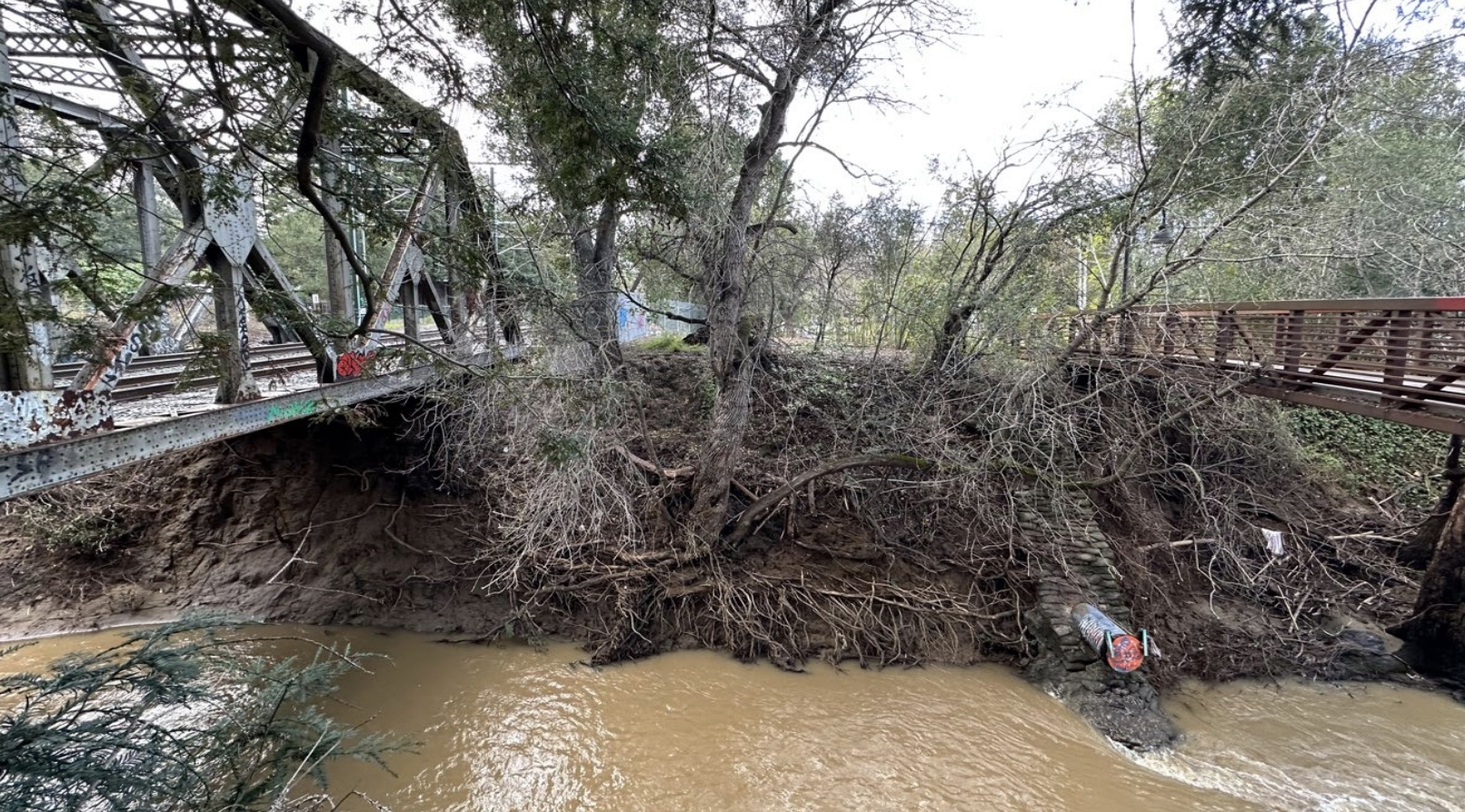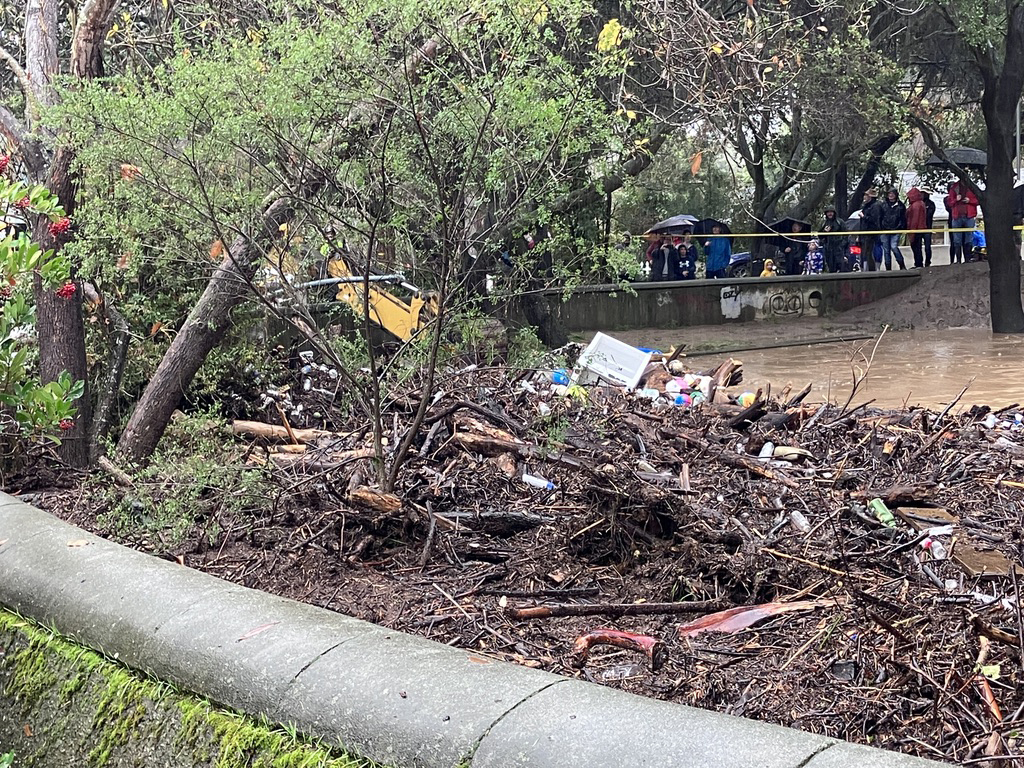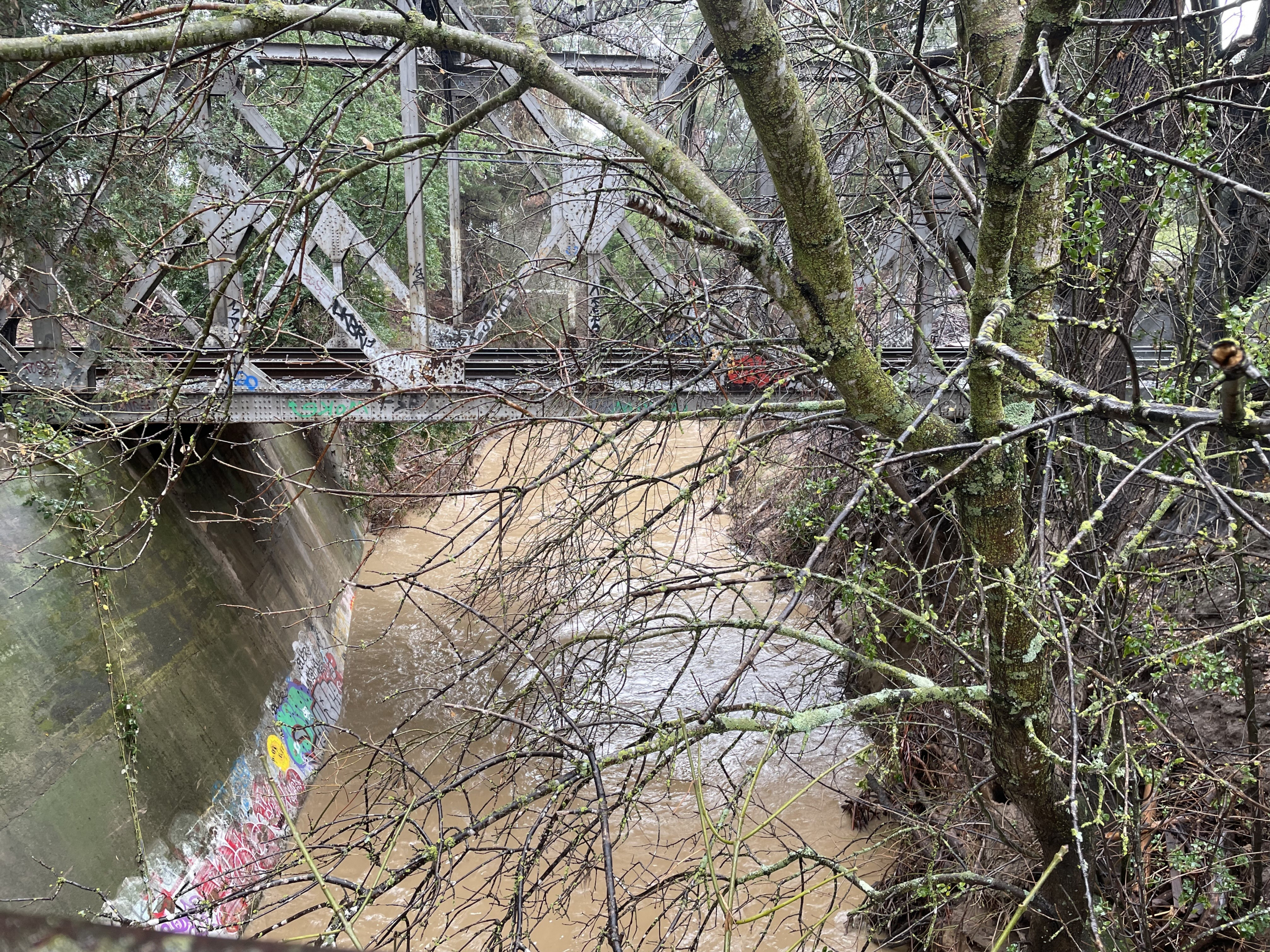Facing the prospect of another wet and wild winter, Palo Alto and Menlo Park are keeping a particularly watchful eye on the San Francisquito Creek rail bridge, an aged steel-truss span next to the iconic El Palo Alto tree at two cities' border.
So is Caltrain, which declared an emergency last spring after discovering eroded soil on the north creek bank that supports the foundation of the 1902 bridge. On Oct. 16, the Palo Alto City Council approved an agreement with Caltrain and Menlo Park that determines how much each of the three parties would pay to repair the bank that supports both the rail bridge and a bicycle bridge that runs parallel to it.
But much to the chagrin of all parties, these fixes won't come in time to protect the bridge during the next rainy season. After Caltrain's consultant recommended in April that the bank be shored up, the transit agency proceeded to commission a contractor, Walsh Construction, to perform the work.
Caltrain also submitted applications to the various state and federal agencies that govern the riparian corridor, including California Fish and Wildlife and the U.S. Army Corps of Engineers.
"They got the materials ready with a short lead time … and had crews ready to go to work," Robert Barnard, Caltrain's deputy chief for rail development, told the agency's board of directors earlier this month.
Then came the setback. The U.S. Army Corps of Engineers determined that they want Caltrain to consult with and get concurrence from the state's preservation office. The determination, which Barnard called "disheartening," effectively made it impossible for Caltrain to begin work this year, in time for the rainy season.
And because work in the creek is not allowed during the winter months because of the presence of endangered species, work now won't kick off until next June, Barnard said at the Oct. 5 meeting.
In the meantime, Caltrain will monitor the bridge during periods of heavy rain and implement an emergency measure if the structure seems unstable: placing a series of "super sacks" — filled with rocks and weighing about a ton each — at the base of the bridge to stabilize it.
"If this winter's weather results in continued erosion, the team will be ready to act to implement a temporary bank stabilization solution, and we're working with the Army Corps of Engineers and regulators as to what that might be," Barnard said.
The permanent bank fixes, which will kick off next year, are expected to cost about $6.5 million, according to the newly approved agreement. Caltrain will pick up about two-thirds of the cost, or $4.3 million, while Palo Alto and Menlo Park will each pay 16.6%, or about $1.1 million.
In addition, Menlo Park will pay $100,000 to replace its storm drain outfall, which was undermined by the high creek flows, according to a report from Palo Alto Public Works Director Brad Eggleston.
The bridge project at Alma Street is distinct from the efforts that Menlo Park and Palo Alto are pursuing further downstream around the San Francisquito Creek, in the areas of Middlefield Road, Chaucer Street and Newell Road.
In those sections of the creek, the channel occasionally cannot contain the creek during major storms. During the Dec. 31, 2022, storm, which was among the strongest on record, water overflowed from the channel and onto the streets in various parts of Menlo Park, Palo Alto and East Palo Alto.
But on Alma Street, the main concern isn't rising water but bridge stability. And while the broader flood-control projects are spearheaded by the San Francisquito Creek Joint Powers Authority, here it's Caltrain that's in charge.
Consternation over delay
Members of the Peninsula Corridor Joint Powers Board, which operates Caltrain, expressed frustration and anger earlier this month when they learned about the permitting delay. Board member Jeff Gee, who serves on the City Council at Redwood City, called the U.S. Army Corps determination on the permit "unacceptable," particularly given Caltrain's early efforts to coordinate its work with its agency.
"You do everything and at the last minute, when the team is assembled, when the budget has been set, after other permits have been assembled from other agencies, this comes in. … It puts our ridership, our organization, our staff and the operations of Caltrain at risk," Gee said at the Oct. 5 meeting.
He and other board members agreed that Caltrain needs to come up with an emergency plan that's implemented as soon as a weather emergency occurs — one that could be put in place without any additional meetings or approvals.
Palo Alto Council member Pat Burt, who currently serves on the Caltrain board of directors and who formerly served on the creek authority board, identified one key challenge in the event of an emergency: the difficulty of predicting a flood before it occurs.
The San Francisquito Creek is a "flash flood" creek, he said. As such, it was impossible to anticipate flooding prior to the Dec. 31 storm.
"I don't get how we're going to necessarily have a trigger in advance that would allow us to act on the emergency basis," Burt said. "We might if we have a two-stage occurrence where a first major storm event puts us in even greater jeopardy. But we can have a first major storm event that is even more severe than that."
The Dec. 31 storm both underscored the urgency of the planned flood-control measures and created fresh complications for the various agencies trying to implement these plans.
The San Francisquito Creek Joint Powers Authority is now revising its hydrological assumptions about the creek — an exercise that could significantly delay its pending and long-delayed plans to replace the Pope-Chaucer Bridge between Palo Alto and Menlo Park. Meanwhile, Palo Alto is spearheading the replacement of the Newell Road bridge, which connects it to East Palo Alto.
In updating the City Council this week, Burt suggested that he doesn't expect the conditions around the rail bridge to present a flood risk or contribute to flood risks.
"Its carrying capacity of water far exceeds what we have down in Chaucer and other locations along the creek," Burt said.





Comments
Registered user
University South
on Oct 19, 2023 at 11:34 am
Registered user
on Oct 19, 2023 at 11:34 am
All suggested fixes to the San Francisquito Creek have been STYMIED BY RED TAPE since at least 1999 when the The San Francisquito Creek Joint Powers Authority was formed--and staffed!. That was after the massive1998 flood. Residents in the area with mortgages are required to have expensive flood insurance. The fixes are obvious and easy. The process? Absurd.
Registered user
Downtown North
on Oct 19, 2023 at 3:15 pm
Registered user
on Oct 19, 2023 at 3:15 pm
Hey, Caltrain! I've got a bunch of river rocks you can absolutely have! Would love to help save the bridge and get rid of these rocks in one fell swoop.